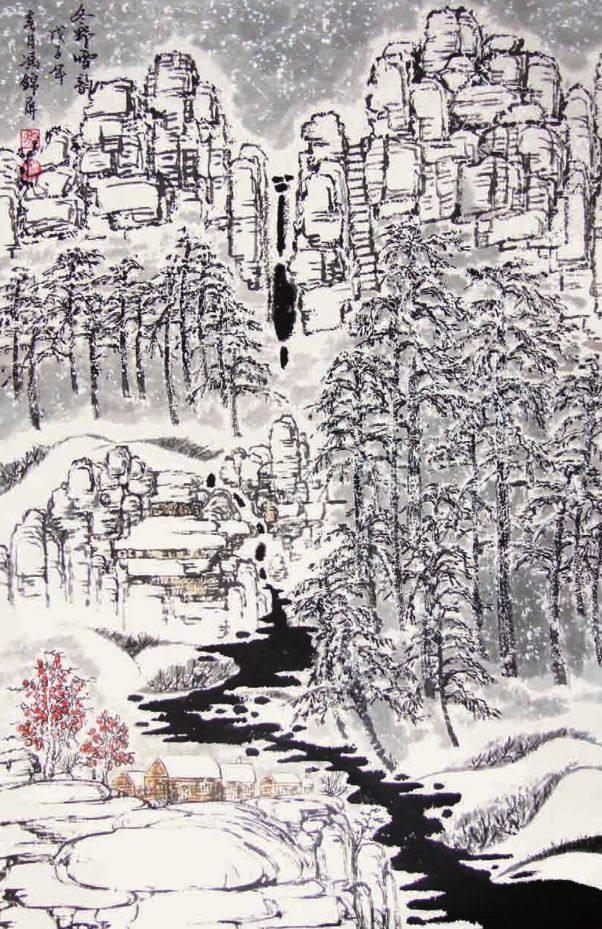Feng Jinping’s Journey from Coal Dust to Canvas
By staff reporter LI WUZHOU
FENG Jinping was born in 1957 in a small vil- lage in Jiangsu Province on Chinas eastern coast. After graduating from high school he worked for years at a local coalmine. Though Feng never received any formal artistic instruction, his passion for painting, along with three decades of self-study and practice, have brought him success and acclaim.
Fengs works have won international respect by virtue of his artistic innovation, notably his ingenious use of vermilion and bright yellow in traditional gentle-hued brush and ink paintings. He blends universal aesthetics with what is in essence high-brow art. His works are imbued with complex cultural codes, which enable people of different social strata and cultures to both comprehend and appreciate Chinese painting and calligraphy.
Centuries ago the decorative function of Chinese painting was disregarded – art was considered the reserve of scholars and officials rather than of everyday people. Fengs works are distinct for their clear composition and sharp hues that are more in line with contemporary mainstream tastes. His style appeals to different social classes and also to international art lovers who, despite knowing little of Chinese culture, both appreciate and admire Fengs works.
Fengs favorite colors are vermilion and bright yellow, which, within Chinese culture, are synonymous with life, joy and dignity. This is why they predominate in Chinas imperial palaces, most notably the Forbidden City. His representative works include Magnificence (Huagui Tu) and Mountains in Red(Wanshan Hongbian).
Feng innovates fearlessly in each of his works, endowing them with distinctive features. He studiously avoids traditional techniques, even in his portrayals of mountains and rock formations.
Besides Chinese painting, Feng also excels at calligraphy and seal cutting. The former features forceful stokes, neat organization and an imposing style that captures the eye and moves the spirit in the same way as does reading a great poem, watching a gracefully executed dance or listening to classical music. Having in his early years intensively imitated the Yan Style, named after Yan Zhenqing (709-785), one of Chinas greatest calligraphers whose works were acclaimed for their innate vigor and strength, Feng has a propensity for writing big Chinese characters in firm, resolute, free-flowing strikes.
Fengs paintings and calligraphy have received recognition abroad for their distinctive exposition of Chinese culture. He has received international awards from countries such as South Korea, Singapore, Japan and Brazil. His works of calligraphy won the gold medal at the World Peace Art Exhibition held to commemorate the 60th anniversary of the founding of the United Nations. His paintings Springtime at Peach Blossom Ravine (Taohuajian Chunse) and Mountains in Red (Wanshan Hongbian) have also been honored at other UN art events, and his Peach Blossom Ravine (Taohua Jian) is part of the UN collection.
Feng has been invited to many international exhibitions – in Brazil, Japan, the U.S., Australia and Singapore – and has helped bring Chinese art and culture to art lovers throughout the world. He is also a permanent member of a U.S.-based international painting and calligraphy association.
Fengs works are well known and widely appreciated in the domestic market. In 2004, Jiangsu Telecom issued a set of telephone cards featuring Fengs landscape paintings, and World Humanities magazine pictured Feng on the cover of its 10th issue in 2006. In 2008, the Twenty Masters of Chinese Calligraphy published by China Federation of Literary and Art Circles Publishing Corporation listed Feng among the most respected names in contempo- rary Chinese art circles, including Li Keran, Huang Yongyu and Wu Guanzhong. He is the youngest among them.

